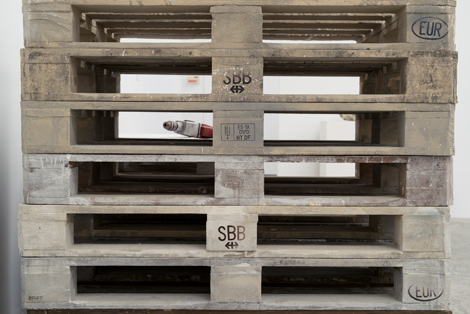Your cart is currently empty!
Peter Fischli and David Weiss

Fischli and Weiss are up to some elaborate shenanigans. Walking in from the street, under the severe brow created by the Ellsworth Kelly block style building-remake of the Matthew Marks Gallery façade, a viewer might think that they were accidentally let in between shows, since the place is strewn with art debris.
Pallets are stacked against the walls, fragments of drywall, peg board, wood panels and other irregularly-cut flat stock are collected in leaning piles; there are power tools, plinths and pedestals, empty cigarette cases, ashtrays lined with butts, paint containers, plastic basins for mixing plaster or joint compound, tires, large inner tubes, pencils, paint brushes and so on, with everything coated in what appears to be a fine sheen of dust. Every once in a while a regular everyday thing intrudes among the art world tools and leftovers: a set of small green rain boots or a toy, or some pills, or a stump-like thing will stand out, but otherwise the scene is perfectly normal for a run-of-the-mill gallery de-install.

1994 – 2013. © Peter Fischli and the estate of David Weiss, Courtesy Matthew Marks Gallery.
What a visitor soon discovers is that they are amidst “Polyurethane Objects,” an ongoing series of castings that the Swiss duo has created since 1982 (though David Weiss died in 2012).
In fact, the only unusual note to going into the gallery is provided by the attendant, who warns repeatedly of not touching anything and of being very careful with the delicate things around. Composed of polyurethane, these objects have been injected with air so the visual effects are less synthetic-looking, but they become more fragile and also rather light.
Fischli and Weiss have long used humor as a core for their collaborative work that began in 1979, so their high jinks come as no surprise. What does surprise is the relative restraint of their Pop Art-derived castings. Somehow, the quirky goofiness of the manner in which similar studio objects were made to perform in The Way Things Go (1982), their signature kinetic installation/film work, is avoided in favor of a more camouflaged approach—a sleight-of-hand/reality switcheroo.
The cast objects are limited to those found in a European artist’s studio. They steer clear of any relationship to American Pop with its iconic approaches, or even the truly democratic and subversive Pop of early days, when an object from any room in the house was fair game (as in Jim Dine and Claes Oldenburg’s “Store” events). At the same time, it makes Fischli and Weiss’ collected clutter seem more temperate, measured and even elegiac. Pop Art, by and large, worked to bring the everyday into the rarefied world of high art. Fischli and Weiss work to displace the everyday in art through humor, poetry and a twinge of melancholy.
In the other Matthew Marks building, “Views of Airports” confirms the artists’ investment in the prosaic. Projecting many slowly merging snapshots the two have taken for years illuminates how a directness and offhandedness can provide interesting glances into the world, without being mediated in a composition or arranged on a pedestal.